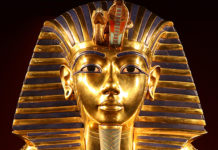Archaeology looks at how the ancient Egyptians made the blue frit pigment that they widely used in decorations.
Egyptian blue and green Frit are pigments that were used in murals and other artistic works throughout Egypt and in parts of Mesopotamia from the New Kingdom period Ca. 1550 BCE until the first century CE (Bianchetti, Talarico, Vigliano, and Ali, 2000). Frit is produced by firing a mixture of copper, lime, quartz and an alkali flux. The city of Amarna, the capital of the Egyptian empire during the reign of Akhenaton (Tutankhamun’s father), had several blue frit ‘factories’, even though the city was quickly abandoned after Akhenaton’s reign. In these factories blue frit was manufactured as cakes which would later be broken down to form a powder that was used to make the pigment.
The Experiment
Hatton, Shortland, and Tite (2008) took 26 primary samples of blue frit from these Amarna factories, as well as 28 samples from elsewhere in Egypt and Mesopotamia to see if they could determine what raw materials went into making the blue frit, and what methods the Egyptians used in the second millennium BCE. The authors used size-exclusion chromatography (SEC) to examine the samples, and backscatter images to measure the lengths of the Egyptian Blue crystals and the diameters of the partially reacted quartz particles. The bulk composition of the samples was analyzed by using an energy dispersive spectrometer. Wavelength dispersive spectrometers were used to analyze the glass phase when present.
Results
Using these methods they determined that sand was probably used for the quartz content, rather than broken up quartz pebbles, the lime too probably came from the sand, as the sands around Amarna contain a high enough calcium carbonate content that more lime would not have needed to be added, for the copper all of the Egyptian samples used 10% tin bronze, while the Mesopotamian samples may have used something closer to a purer copper ore. The alkali flux was made from the soda rich ashes of certain plants after burning, rather than natron as might be expected of the Egyptians.
Thoughts
Archaeology is the study of past peoples by looking at their material culture. The more the archaeologist knows about the material culture of the times and places that he or she is studying, the better the archaeologist is able to come to anthropological conclusions. Experiments such as those conducted by Hatton et al. are vital to furthering our understanding of the material culture of the past. Plus, the science is just cool.








